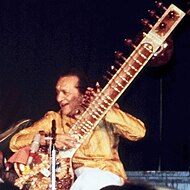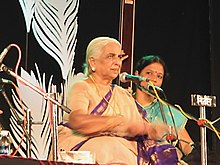Thumri is a vocal genre or style of Indian music. The term "thumri" is derived from the Hindi verb thumuknaa, which means "to walk with a dancing gait in such a way that the ankle-bells tinkle." The form is, thus, connected with dance, dramatic gestures, mild eroticism, evocative love poetry and folk songs, especially from Uttar Pradesh, though there are regional variations.
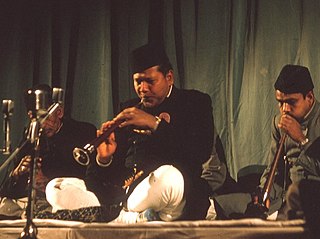
Ustad Bismillah Khan, often referred to by the title Ustad, was an Indian musician credited with popularizing the shehnai, a reeded woodwind instrument. He played it with such expressive virtuosity that he became a leading Hindustani classical music artist. His name was indelibly linked with the woodwind instrument. While the shehnai had importance as a folk instrument played primarily by musicians schooled in traditional ceremonies, Khan is credited with elevating its status and bringing it to the concert stage.

Ustad Allauddin Khan, was an Indian sarod player and multi-instrumentalist, composer and one of the most notable music teachers of the 20th century in Indian classical music. For a generation many of his students, across different instruments like sitar and violin, dominated Hindustani classical and became one of the most famous exponents of the form ever, including Khan.

The Mewati gharana is a musical apprenticeship tribe of Hindustani classical music. Known for being Pandit Jasraj's musical lineage, the gharana was founded by brothers Ghagge Nazir Khan and Wahid Khan (beenkar) of Indore in the late 19th century at the Holkar Court. Members of this gharana have had an active influence in Indian cinema for over half a century.

Sankat Mochan Hanuman Temple is a Hindu temple in Varanasi, Uttar Pradesh, India and is dedicated to the Hindu God Hanuman, in his form as "Sankat Mochan," meaning the "reliever from troubles".. The temple was established by famous Hindu preacher and poet saint Sri Goswami Tulsidas in the early 16th century and is situated on the banks of the Assi river.

Siddheswari Devi was a legendary Hindustani singer from Varanasi, India, known as Maa (mother). Her music embodied the Banaras Gharana style, which focuses on conveying deep emotions and feelings through musical notes and voice modulations. A stalwart figure in thumri, Siddheshwari's repertoire also encompassed khayals, dhrupads, dadras, tappas, kajris, chaitis, horis, and bhajans.
Pandit Kishan Maharaj was an Indian tabla player who belonged to the Benares gharana of Hindustani classical music.
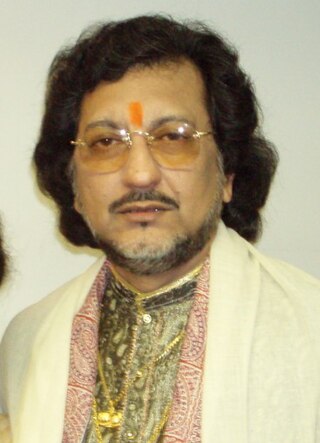
Pandit Kumar Bose, born 4 April 1953, is an Indian tabla musician and composer of Indian classical music.
Yaman is a heptatonic (Sampurna) Indian classical raga of Kalyan Thaat.
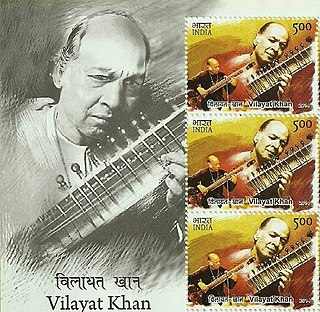
Ustad Vilayat Khan was an Indian classical sitar player, considered by many to be the greatest sitarist of his age. Along with Imdad Khan, Enayat Khan, and Imrat Khan, he is credited with the creation and development of gayaki ang on the sitar.

Goonj Uthi Shehnai is a 1959 Hindi film directed by Vijay Bhatt, with Rajendra Kumar, Ameeta, Anita Guha and I. S. Johar as leads. The film has music by Vasant Desai and lyrics by Bharat Vyas, and the duo created numerous hits such as "Jivan Men Piya Tera Sath Rahe" sung by Lata Mangeshkar and Mohd. Rafi, and Lata's "Tere Sur Aur Mere Geet" and "Dil Ka Khilona Hai Toot Gaya".

Rasoolan hussain was a leading Indian Hindustani classical music vocal musician. Belonging to the Benaras gharana, she specialized in the romantic Purab Ang of the Thumri musical genre and tappa.

Ustad Rais Khan was a Pakistani sitarist. At his peak he was regarded as one of the greatest sitar players of all time. He continued performing till his last days. He moved from India to Pakistan in 1986, where he took up Pakistani citizenship.
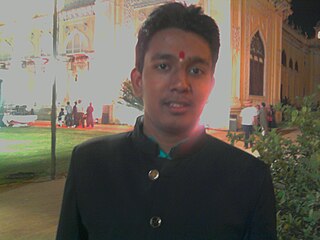
Baba Bhaskar Nath is an Indian classical instrumentalist. He plays shehnai. Belonging from the Meerut Shehnai Gharana, he is considered a child prodigy.
Mohammad Sharif Khan known as Ustad Sharif Khan Poonchwaley was a classical player of sitar, vichitra veena and raza been in the hindustani classical music tradition.
Ashutosh Bhattacharya was a noted Indian classical musician of Hindustani classical music from Varanasi, who was Tabla player and music educator, besides a practicing Ayurvedic doctor.

Kamala Bose (Bengali) (1947–2012) was a prominent Indian classical vocalist.
Anant Lal, often referred to by the title Pandit, was an Indian classical musician who played the shehnai. He worked for All India Radio and played with artists such as Ravi Shankar and Debu Chaudhuri in addition to recording under his own name. Lal was one of the leading exponents of the shehnai in Hindustani classical music. In 1989, he received the Sangeet Natak Akademi Award, the highest recognition afforded artists in India.

Pandit S. Ballesh Bhajantri is a popular Indian classical Hindustani shehnai player. He is a disciple of shehnai player Ustad Bismillah Khan, he is benares gharana shehnai player and a patiala gharana hindustani vocalist, ghazal singer, Indian playback singer and musician, Ballesh is credited with popularizing the shehnai, a reeded woodwind instrument. He is also a Prasar Bharati's All India Radio (AIR) and Doordarshan artist.
